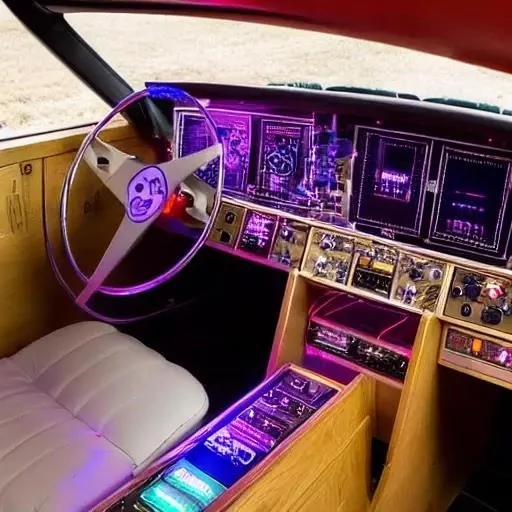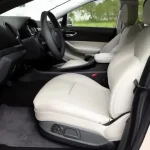Remember the exhilarating promise of the DeLorean’s dashboard, bristling with futuristic readouts and capabilities, in the iconic film Back to the Future? What once seemed like pure science fiction, a whimsical glimpse into an impossibly distant era, is now rapidly materializing within the automotive industry. Today, designers and engineers are not just dreaming; they are actively shaping vehicle interiors that transcend mere transportation, transforming our cars into dynamic, intelligent, and deeply personalized cocoons of technology and comfort. This isn’t just about bigger screens; it’s about an entirely reimagined relationship between human and machine, fostering an environment where every journey becomes an experience, not just a commute.
The convergence of advanced artificial intelligence, sustainable material science, and groundbreaking human-machine interfaces is propelling us into an era where our cars anticipate our needs, adapt to our moods, and seamlessly integrate into our digital lives. From intuitive voice assistants that learn our preferences to augmented reality displays that overlay navigation onto the real world, the future of the car interior is no longer a distant vision but an unfolding reality. By integrating insights from AI-driven data analytics and embracing user-centric design principles, manufacturers are crafting spaces that are incredibly effective, remarkably comfortable, and profoundly forward-thinking, making every drive feel like a journey into tomorrow.
| Category | Key Concept/Feature | “Back to the Future” Parallel | Modern Industry Examples/Trends | Impact on User Experience |
|---|---|---|---|---|
| Digital Cockpit & HMI | Integrated multi-screen displays, holographic projections, intuitive voice control. | DeLorean’s digital readouts; interactive controls. | Mercedes-Benz MBUX Hyperscreen, BMW i Vision Dee’s mixed reality slider, Tesla’s minimalist central display. | Seamless information access, reduced physical buttons, personalized interaction. |
| Connectivity & AI Integration | Predictive AI, personalized profiles, over-the-air updates, smart home integration. | The DeLorean’s ability to travel through time based on programmed input. | Google Built-in in Volvo/Polestar, Amazon Alexa integration, self-learning navigation systems. | Anticipates needs, offers proactive assistance, adapts to individual preferences. |
| Sustainable & Advanced Materials | Recycled plastics, vegan leather, bio-based composites, self-healing surfaces. | The future’s resourcefulness implied by advanced tech. | BMW i Vision Circular’s fully recyclable interior, Polestar 2’s WeaveTech vegan interior, upcycled materials in various concepts. | Eco-conscious luxury, enhanced durability, unique tactile experiences. |
| Autonomous Driving Preparedness | Reconfigurable seating, lounge-like layouts, retractable controls. | The idea of the car as more than just a driving machine. | Mercedes-Benz F 015 Luxury in Motion concept, Waymo’s self-driving vehicle interiors. | Transforms cabin into a mobile living room or office, frees up passenger time. |
| Sensory Experience | Customizable ambient lighting, integrated scent dispensers, haptic feedback. | The feeling of stepping into a different era. | Audi’s ‘Light Stage’ illumination, Carfume systems, haptic feedback on touchscreens. | Enhances mood, reduces stress, creates a unique atmosphere for each journey. |
Reference: Automotive IQ ⸺ Interior & HMI Innovations
The shift towards an intelligent, intuitive cabin is dramatically reshaping our driving experience. Imagine stepping into a vehicle that instantly recognizes you, adjusts the seating, mirrors, and climate to your exact preferences, and even suggests a playlist based on your calendar or mood. This level of personalization, once confined to the realms of cinematic fantasy, is becoming a hallmark of luxury and innovation. Leading manufacturers like Audi and Mercedes-Benz are already implementing sophisticated AI-driven infotainment systems that learn from user behavior, offering predictive suggestions for routes, media, and even restaurant recommendations, making every interaction feel incredibly organic and tailored.
Beyond the digital realm, the physical environment of the car interior is undergoing a profound transformation. Designers are increasingly focusing on creating multi-functional spaces that adapt to various needs, whether it’s a mobile office during a commute, a serene lounge for relaxation, or an immersive entertainment hub for families. Sustainable and ethically sourced materials are rapidly becoming the norm, with companies like Polestar championing vegan interiors and BMW exploring fully recyclable concepts. This commitment to environmental stewardship, coupled with advancements in material science, means future interiors will not only be luxurious and technologically advanced but also remarkably durable and kind to the planet, reflecting a holistic approach to design.
The advent of autonomous driving technologies is perhaps the most significant catalyst for this interior revolution. As vehicles increasingly take over the task of driving, the traditional cockpit arrangement, with its emphasis on driver-centric controls, is giving way to more flexible and expansive designs. Seats can swivel to face each other, steering wheels can retract, and dashboards can transform into expansive display surfaces. This paradigm shift, actively explored in visionary concepts like the Mercedes-Benz F 015 Luxury in Motion, redefines the car’s primary purpose. It transitions from a mere mode of transport to a truly mobile living space, allowing occupants to work, socialize, or simply relax during their journeys, maximizing their time and enhancing their overall well-being.
The journey from the fantastical visions of Back to the Future to the tangible innovations gracing our showrooms today is a testament to human ingenuity and relentless technological pursuit. While challenges remain, including balancing cutting-edge technology with user simplicity and ensuring robust cybersecurity, the trajectory is unmistakably optimistic. The future of car interiors promises an unprecedented blend of comfort, connectivity, and personalization, offering a glimpse into a world where our vehicles are not just machines, but intelligent, adaptive partners in our daily lives. As we continue to push the boundaries of design and engineering, the car interior is poised to become an even more exciting, dynamic, and indispensable part of our future, truly bringing yesterday’s dreams into tomorrow’s reality.






